Greenhouse Company In Kenya
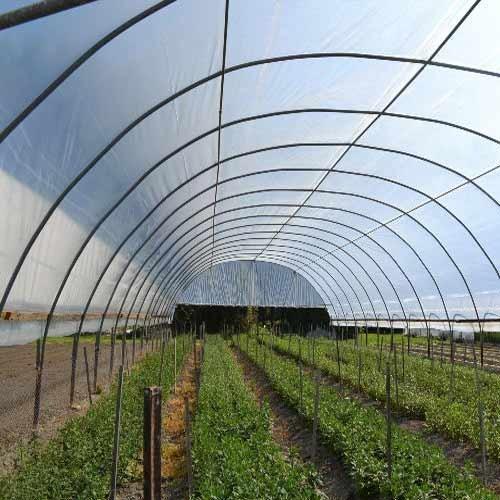
Grekkon Limited is the low cost premier greenhouse company in Kenya, known for its galvanised steel tunnel type, and open ventilation type units. We provide affordable greenhouses in Kenya with each unit constructed tailored to the grower’s specifications.
There is a choice of wooden or metallic greenhouses from our choice of low cost greenhouse construction in Kenya. All greenhouse sizes unit have a drip irrigation system installed, with water supplied via a HDPE pipe
How To Construct A Greenhouse
- Assessment of the location. Is it high, mid or low altitude? Tunnel type units are for the highlands and cooler areas. Open ventilation type units for the warm mid to coastal locations
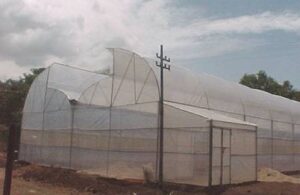
Open ventilation type greenhouse
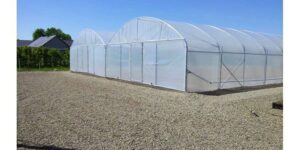
Tunnel type greenhouses
2. Check the land topography, and water availability. This determines the greenhouse location
3. Understand the target crop type.
This informs us if the unit will have an internal crop support system, and how strong it should be. A strawberry greenhouse will need none, but a tomato or pepper unit will. It advises on the greenhouse net to install. Strawberry and tomato will have different nets on the sides
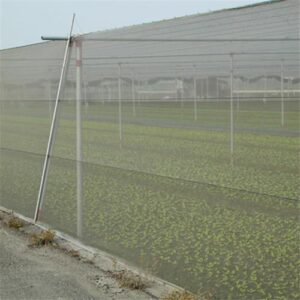
An insect net on the side to keep away pests
4. Material selection.
- Galvanised steel. Galvanisation keeps it from rust
- UV treated greenhouse polythene with anti-drip properties. UV treatment prevents rapid sun degradation, anti- drip treatment prevents dew formation on the paper. Dew drops falling on the crop are a precursor to fungal diseases. It covers the top and sides of a greenhouse structure to protect the plants within from the elements. It allows in the right spectrum of light for crop growth while filtering away the less needed part of light by the crop. All this creates a an internal environment favourable to plant growth regardless of the external environment. This allows for all year production, improves crop yield and quality
- UV treated insect/ bird net. The former keeps away insect pests, while the latter allows in insects for pollination, but prevents entry of bird pests
- Stainless steel profiles and plastic coated wiggle wires hold the greenhouse paper and netting onto the steel frame
As a greenhouse company in Kenya, the above are the key considerations we make when advising growers on the choice of greenhouse units
Greenhouse Prices In Kenya
1. Metallic
| Greenhouse Type | ||||
| Tunnel Type | Open Ventilated Type | |||
| Greenhouse Size | 15M x 8M | 290,000 | 330,000 | |
| 20M x 8M | 300,000 | 340,000 | ||
| 24M x 8M | 320,000 | 350,000 | ||
| 30M x 8M | 460,000 | 540,000 | ||
| 40M x 8M | 575,000 | 655,000 | ||
| 15M x 16M | 460,000 | 555,000 | ||
| 24M x 16M | 620,000 | 665,000 | ||
| 30M x 16M | 900,000 | 990,000 | ||
| 40M x 16M | 1,100,000 | 1,240,000 | ||
2. Wooden
| Dimensions in meters | Tomato Crop Population | Price in KES |
| 15 x 8 | 600 | KES 140,000 |
| 24 x 8 | 800 | KES 160,000 |
| 30 x 8 | 1,200 | KES 190,000 |
| 30 x 16 | 2,500 | KES 370,000 |
How To Construct Timber Greenhouses
i. Know the crop type to plant. This will guide on the greenhouse design and amount of material to use. For instance, a tomato greenhouse will take more material than one with herbs. This is because tomato will require training, and herbs won’t. It also guides on the greenhouse paper to cover with. You will have more light for fruiting crops like tomato, capsicum, chilli, cucumber, and strawberry, or bi/ multicolored flowers. Have a clear polythene for these. Mono-color flowers will have the yellow polythene cover
ii. Determine the plant population you need. This informs the area of the greenhouse
iii. Once you determine the amount of timber required based on the greenhouse area, treat it. This is to prevent weevils and termites from attacking the timber which reduces it’s lifespan. Do not apply motor oil on the timber as treatment. This is because it will contaminate food crops in the greenhouse
iv. Your construction design is the vented type. This is because the wood cannot be curved to a tunnel type design
v. Cover the roof and side ventilation with an insect net. Select the high density gauge which is effective in keeping away white-flies
vi. Make the beds according to the crop type. Beds are important in managing drainage. For seedling production, set up the tables 1M high
vii. Set up the drip irrigation system on the beds. For seedling production, set up he misting or fogging system above. The misters or foggers are 1M apart
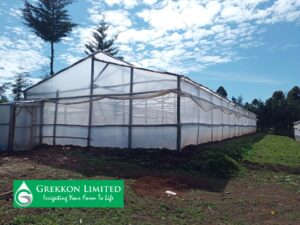
A wooden greenhouse by Grekkon Limited
How to Choose Greenhouse Nets
Greenhouse nets allow for ventilation of the crops, and personnel working in the unit. Below are the consideration made when deciding the choice of greenhouse net to install on the sides
1. Crop type. Some crop types require higher light intensity than others. In this case, a lower shade % net is appropriate for the former. Fruiting crops such as; tomato, strawberry, capsicums, and so on require more light than leafy vegetables. Examples are; cabbage, spinach, collards, kale etc.
2. Crop stage of growth. The shade net in the nursery will block out more heat, than the one for established crops in the field
3. Location of the farm. In the highlands where the heat intensity is less, a lower shade net will protect crops well. In the mid to low altitudes where it’s hotter, a higher shade net works best.
4. Latitude. Countries such as Kenya lie along the equator where solar radiation is high. Your choice of greenhouse net will have higher UV treatment than that of a temperate region

A bird net on a strawberry greenhouse to allow in insects for pollination, while keeping away bird pests
Greenhouse Company In Kenya
FAQs
a. What materials are needed to build a greenhouse?
- UV treated greenhouse polythene
- Steel pipes
- Insect netting
- Profiles and wires
b. Can I grow year-round in a greenhouse?
Yes because the crop is protected from the elements of weather
c. Do greenhouses make money?
Yes they do with a high-value crop
Related Posts
Greenhouse Construction In Kenya
Greenhouse construction in Kenya vary from small units of 120M sq, to large commercial units occupying ten of acres. The table below...
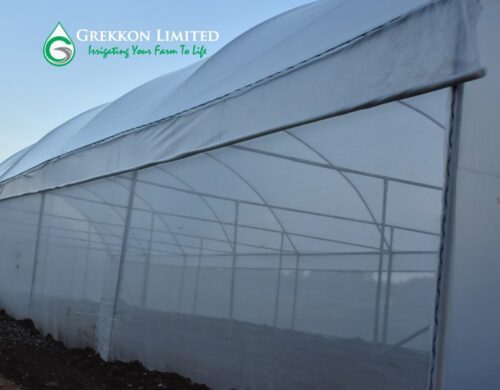
Affordable Greenhouses In Kenya
As a greenhouse company in Kenya, our affordable greenhouses in Kenya vary depending on the size, design, choice of crop, and the level of...
